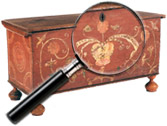|
|
Burlon B. Craig
During the 1950′s and 1960′s, the long line of potters from central North Carolina thinned to one man: Burlon B. Craig (1914 to 2002). Craig’s persistence, skill, adaptability and willingness to instruct a new generation saved the Catawba Valley pottery tradition. Today, over 20 contemporary potters around Hickory, North Carolina, owe their livelihood to him.
Craig began his pottery career in the Great Depression when pottery was far from decorative. [...] Click here to continue reading.
Walter I. Cox (1866-1930)
Walter Cox was pa painter born in Broxwood Court, England on May 4, 1867. After studying in Paris with Laurens, Lefebvre, and Benjamin-Constant, Cox came to San Francisco in 1904 and resided at 1717 Jackson Street with a studio at 1612 Van Ness. He lost many paintings in the 1906 disaster and was active in San Francisco until at least 1914. Sketching trips were made to England and Scotland. Cox [...] Click here to continue reading.
John Wallace Cowden Pottery
John W. Cowden began his pottery business in Harrisburg, Pennsylvania in 1861, assisted by his son Frederick until the younger Cowden enlisted in the Union Army for the Civil War. They were known for their utilitarian stoneware with brushed cobalt blue floral decoration. In 1870 Isaac J. Wilcox joined the business and the firm became Cowden & Wilcox. John W. died in 1872 and was followed by his sons in [...] Click here to continue reading.
Frederick H. Cowden Pottery
Frederick H. Cowden was the son of John Wallace Cowden, founder of the Cowden Potteries in Harrisburg, Pennsylvania in 1861. Frederick worked briefly with his father at the pottery before enlisting in the Union Army for the Civil War.
He returned to the pottery after the war and worked with his father and Isaac J. Wilcox in the firm of Cowden & Wilcox. John W. died in 1872 and Frederick [...] Click here to continue reading.
Eanger Irving Couse (American, 1866 to 1936)
As a child Eanger Irving Couse admired the Chippewa Indians who lived near his home in Saginaw, Michigan. He knew from an early age that he wanted to be an artist, and his earliest attempts at drawing were of Native American subjects. At age seventeen he left home for Chicago, where he studied briefly at the Chicago Art Institute, followed by two years at the National Academy [...] Click here to continue reading.
William Henry Cotton (American, 1880 to 1958).
William Cotton painted portraits, wrote two Broadway plays, and in his day was one of the best known caricaturists in the country. He studied at the Cowles Art School in Boston and at the Academie Julian in Paris. A portrait painter, he founded the National Association of Portrait Painters. He worked for Vanity Fair from 1931 to 1936 as an illustrator. Eleanor Roosevelt deemed his drawing of [...] Click here to continue reading.
Corrie Parker McCallum (American, 1914 to 2009)
Corrie Parker McCallum was born in Sumter, South Carolina, in 1914. As a child, her first acts of creative expression came during early years spent in bed recovering from tuberculosis. She would draw illustrations for stories her uncle would read to her. Sumter didn’t offer much in the way of art education, even though her cousin Elizabeth White was a well-known artist living in Sumter. McCallum [...] Click here to continue reading.
Jean Baptiste Camille Corot (1796-1875)
Jean Baptiste Camille Corot was born in Paris in 1796 to a well-to-do family. Initially trained for business, at 26, Corot began his career as an artist. He studied under Achille Michallon and Victor Bertin, and he traveled throughout France, as well as in England, Switzerland, and Italy. Corot exhibited at the Paris Salon frequently, and also at the 1862 International Exhibition in London. Though slow to receive recognition [...] Click here to continue reading.
Robert Cornelius (1809-1899)
Among the first practitioners of daguerreotypy in America, Robert Cornelius is credited with taking the first true photographic portrait in America – a self-portrait.
Cornelius was a pricipal in the family lighting fixtures business in Philadelphia and had an extensive background in metal plating techniques. In October, 1839, Cornelius began to experiment with daguerreotype plates, and in early of December of the same year, he combined talents with Dr. Paul Beck [...] Click here to continue reading.
Helen Quintana Cordero (1915 to 1994)
Helen Cordero of the Fox Clan was a prominent Cochiti potter. Among many accolades she has been published most recently in Artfocus Nov./ Dec. 1999:10-11; Native Peoples Summer 1999:4; and Indian Market Magazine 1998:65. Most famous for her storytellers, she begun her career potting small figures of animals and birds, signing her name in pen or pencil. It wasn’t until later that her name appeared in vegetal paint. [...] Click here to continue reading.
|
Recent Articles
- Charles Alfred Meurer – American Artist & Tromp L’Oeil Artist
- Sendak, Maurice – American Artist & Writer
- Godie, Lee – American Artist
- Davis, Vestie – American Artist
- Bartlett, Morton – American Artist
- Mackintosh, Dwight – American Artist
- Evans, Minnie Jones – African-American Artist
- Mumma, Ed (Mr. Eddy) – American Artist
- Nice, Don – American Artist
- Savitsky, John (Jack) – American Artist
- Gordon, Harold Theodore (Ted) – American Artist
- Dial, Thornton – African-American Artist
- Doyle Sam – American Artist
- Johnson, Lester Frederick – American Artist
- Finster, Howard – American Artist
|
|
